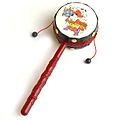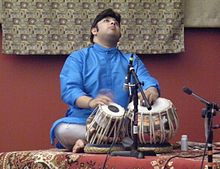drum
In musicology, a drum (from mhd .: Trume [ loud .]) Is a musical instrument in which the sound is produced with a stretched vibration membrane , the so-called skin. The technical term for this is membranophone . In colloquial language, instruments whose skin is played directly with mallets or hands are usually referred to as drums. Occasionally the term is extended to other percussion instruments in this context , more rarely to other instruments. Drums are used all over the world in a variety of ways as rhythm , effect or signal instruments and are among the oldest musical instruments known to man. They are often played in combination with other percussion or percussion instruments , for example with the percussion of the classical orchestra or with contemporary drums .
origin
From Central Europe are for the 4th and 3rd millennium BC BC numerous ceramic objects, mostly hourglass-shaped, so-called clay drums , which are mainly interpreted as musical instruments. Some of the oldest known wooden drums come from China. The drums covered with crocodile skins from the 3rd millennium BC Were discovered in the Neolithic site Taosi . The oldest Egyptian drum had a cylindrical body and comes from a rock tomb in Beni Hasan . It is dated to the 12th dynasty (around 2000 BC). More common were barrel-shaped drums, which, like frame drums, were used for military purposes and perhaps also in the temple at this time.
Demarcation
Beating, plucking, rubbing and singing drums
In instrument science , musical instruments are often classified according to the type of sound they produce . According to the Hornbostel-Sachs classification , the terms membranophone and drum are synonymous. A distinction is made between beating drums, plucking drums, friction drums and singing drums , depending on how the vibration membrane is played. The singing drums therefore also include the kazoo - which at first glance resembles a wind instrument , since a stretched paper is played here by the human voice and thus set in motion, comparable to "blowing" on a comb. An example of the plucked drum is the Indian ektara or gopi-yantra , where a single string attached to a skin is plucked when played . The banjo , on the other hand, is classified as a chordophone ( string instrument ), although the strings attached to the bridge also cause a stretched skin to vibrate. The caixa , whose strings and skin attached to the body are struck, is in turn considered to be a beating drum. The friction drums include, for example, the humming pot , the cuíca , the Italian putipù or the Ukrainian buhaj ( Ukrainian : бугай ). A sub-category of beating drums are the rattle drums , the skin of which is played indirectly - indirectly by balls.
Even speakers produce sound by vibrating diaphragm, but are not usually as a musical instrument.
The kazoo is a singing drum .
The Ektara is one of the plucking drums.
Rattle drum : Chinese children's toy bolang-gu .
Drum and timpani
Some definitions differentiate between drum and timpani in Western music . Accordingly, when the drum is played, the noise predominates , while the timpani is tuned to a certain tone with a clearly defined pitch. A mechanism allows the head of the timpani to be stretched while playing, thereby changing the pitch of the note so that the instrument can be used tonally.
The difference is noticeable, for example, in the symphony orchestra, where the big and small drums are played by the percussionist , but the timpani is played by the timpani. The Indian tabla is also considered a kettledrum because of its similar structure, its name can be traced back to tabl (Arabic: 'drum'). It does not have the same tensioning mechanisms as the orchestral timpani; the pitch can be varied using different touching techniques. The African talking drum, on the other hand, has tensioning mechanisms that are similar to those of the orchestral timpani, but due to their different structure is not part of the timpani. The tom-tom of contemporary drums can have a defined pitch and is sometimes referred to as a "jazz timpani", but is one of the drums.
Basically there are different definitions of what constitutes the pitch of a note, with a distinction being made between pitch perception (pitch) and pitch resolution (pitch) ( see also: Universals of music perception , psychoacoustics ).
Drum, percussion instrument, percussion

Colloquially, all percussion instruments are usually referred to as drums that are covered with one or more skins made of animal skins, plastic or other thin material. Most of the time, rhythm is in the foreground when playing , while precise tonality often plays a subordinate role. With many drums the noisy character predominates in the sound. Instruments that are rhythmically used or drums comparable to percussion drums or that produce sounds similar to these are occasionally added to the drums, especially some idiophonic percussion instruments (such as slit drums and idiophonic water drums ), but also other instruments (such as jew's harps ). Instead, such instruments are often grouped together with percussion drums under more general terms such as percussion or drums . In popular music styles, the drums are also known as drum kit or drum set (English for: ' drum set ') or drums ( 'drumming') for short , a drummer is accordingly called a drummer ('drummer').
The transition between membranophonic Fellklinger and idiophonic self-klinger is sometimes fluid. For example, a tin can can be viewed as a drum covered with a metal membrane or, like a gong, as an idiophone. A special borderline case is the large circular copper kettle Mizhavu from South India, whose skin, stretched over a tiny opening, is beaten with the hands. The transition between beating and rubbing a drum can also be fluid. For example, when playing drums with a broom, the instruments are occasionally struck, but occasionally also rubbed.
There are drums whose main function is not percussive but rather as melodic instruments. For this purpose, several drums, tuned to exact pitches, are arranged in a semicircle around the player, as in the Indian drum circle Tabla Tarang or the Hsaing Waing , the leading melody instrument of the Burmese orchestra. In the south Indian, hourglass-shaped wooden drum Idakka , the membrane tension can be changed so much that a range of two octaves can be played.
Percussion instruments that play with tonality in the foreground and that do not require a skin - such as glockenspiel , vibraphone or piano - are usually not referred to colloquially as drums.
Classification
- Hand drum , struck with the hands, regardless of the type
- Kettle drum , single-headed, body closed at the bottom, with orchestral timpani
- Message drum , collective term according to the function, regardless of the type
- Frame drum , single-headed, less often double-headed frame, the height of which is less than the membrane radius
- Tubular drum , body is tubular
- Hourglass drum , a tubular drum whose body diameter in the middle is smaller than the two end diameters
- Fassstrommel, a tubular drum whose body diameter in the middle is greater than the two end diameters
- Single-skin drum, drum with only one skin ( bongos , timbales , conga , tumba , tom-toms )
Some familiar drums
- Basler drum , double-headed drum of the Basler Volksmusik
- Batá drum , hourglass-shaped double -skin drum of the Yoruba
- Bongos , small Cuban drum pair
- Conga , high, single-headed Cuban drum pair
- Djembé , West African cup drum
literature
- Klaus Hubmann , Gerlinde Haid : drum. In: Oesterreichisches Musiklexikon . Online edition, Vienna 2002 ff., ISBN 3-7001-3077-5 ; Print edition: Volume 5, Verlag der Österreichischen Akademie der Wissenschaften, Vienna 2006, ISBN 3-7001-3067-8 .
- Karl Peinkofer, Fritz Tannigel: Handbook of the drums. Practice and technology . Schott, Mainz 1969 ff., Pp. 76-109
Web links
- Drum Museum (information and pictures about drums from New Guinea, Africa and the Himalayas by Ulli Siebenborn)
Individual evidence
- ↑ Rudolf Ohlig (editorial management): Meyer's large pocket dictionary . Volume 22. BI-Taschenbuchverlag, Mannheim / Leipzig / Vienna / Zurich 1995, ISBN 3-411-11005-8 , p. 212.
- ^ Robert Anderson: Musical Instruments. In: Kathryn A. Bard (Ed.): Encyclopedia of the Archeology of Ancient Egypt. Routledge, London / New York 2005, p. 659 ( archive.org )
- ↑ Dilip Ranjan Barthakur: The music and musical instruments of North Eastern India , Mittal Publications, New Delhi 2003, ISBN 81-7099-881-6 , p 129. ( online )
- ↑ a b Angelika Rehm, Dieter Rehm: Von Pauken und Trompeten , Persen Verlag, Buxtehude 2006, ISBN 3-8344-3867-7 , p. 8. ( online )
- ↑ Drumming. In: Digital dictionary of the German language . Retrieved August 29, 2010
- ↑ Wieland Ziegenrücker: General music theory with questions and tasks for self-control. German Publishing House for Music, Leipzig 1977; Paperback edition: Wilhelm Goldmann Verlag, and Musikverlag B. Schott's Sons, Mainz 1979, ISBN 3-442-33003-3 , p. 179.





